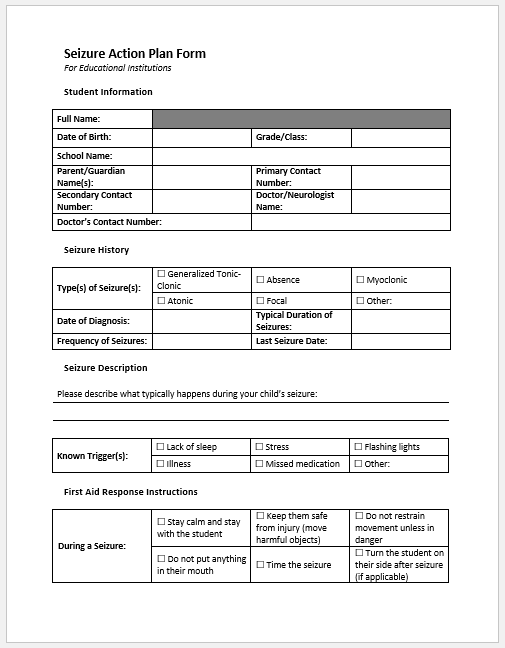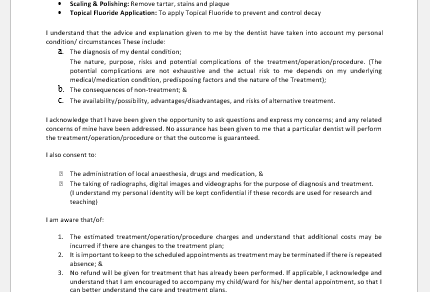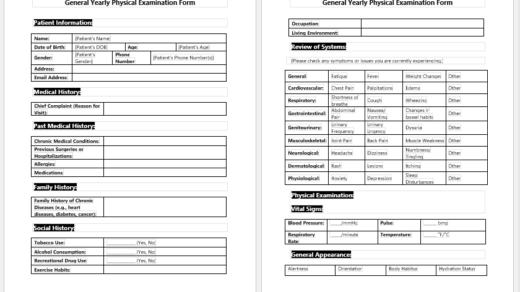Students with any type of disorder or health condition require special care, especially when they are away from home for extended periods. They typically spend most of their time at the school or college where they are enrolled. Therefore, both the guardians and the school administration must ensure that the child receives the necessary support and does not face any difficulties while being away from home.
In addition, it is important to note that children with special health conditions often struggle to express how they are feeling. As a result, they require more attention and care from the school compared to other students.
What is a seizure action plan form?
A Seizure Action Plan Form is a document used by educational institutions to support students with a history of epilepsy. Managing a person experiencing a seizure can be challenging, and those around them often panic due to a lack of knowledge about the appropriate steps to take. This form helps ensure that staff and caregivers are prepared to respond effectively and confidently in such situations.
To address this issue, schools and colleges require a form to be completed by either the healthcare practitioner or the student’s parents.
The top reasons to use the seizure action plan form are:
Preparedness for supporting a student with Epilepsy
When a school becomes aware that a student has a history of epilepsy and requires special attention, it must take steps to understand how best to provide appropriate care. In other words, the school should implement preparedness measures to ensure the student receives prompt and effective assistance in the event of a seizure, minimizing any risk or delay in treatment.
The form helps the school collect data, which in turn enables it to be better prepared for any situation that may arise.
Understanding the individual needs of students with Epilepsy
There may be many students living with epilepsy, and each individual’s needs and treatment plan can vary significantly. Every student requires personalized care, which may differ based on factors such as age, gender, the physician’s recommendations, and other medical considerations.
To effectively meet the needs of each student, schools require individualized treatment plans, as relying on a single, uniform approach can be risky and ineffective. To support this, a form has been developed that encourages individuals to provide detailed information. This enables school management to address and manage each student’s situation appropriately and with the necessary care.
Responding to Seizures: The importance of awareness
Those who have never encountered someone experiencing a seizure may not know how to respond effectively in the moment to prevent long-term harm. Therefore, it is essential that people around such individuals are educated on how to intervene appropriately and understand the steps to take during a seizure.
When properly trained and well-informed, individuals can intervene promptly and help prevent a student from experiencing a severe epileptic seizure. In some cases, timely action can even stop the seizure from occurring altogether. Taking the right steps at the right time is essential for ensuring the student’s safety and well-being.
What are the sections of the form for seizures?
Typically, this form includes the following elements:
Details of the student:
The details of the person for whom the form is being filled should be provided accurately. This information will help the school quickly identify the student and ensure that any necessary treatment can be administered promptly and efficiently.
Seizure history and treatment information
This section of the form gathers details about a student’s history of seizure episodes. It also records the treatments that have been administered in the past. This information helps the school understand the student’s medical needs and respond appropriately in case of an emergency.
Coordination with the student’s doctor
The school is also familiar with the doctor treating the student, making it easier to contact them for medical advice and guidance on how to care for the student within the school environment.
Emergency actions:
In case of an emergency, the actions to be taken, along with the contact person, should be clearly mentioned in this form.
List of medications:
A list of medicines the student is currently taking for their medical condition is provided in this form, along with the correct dosages. The symptoms to watch for before administering the medication are also clearly outlined in the form.

Template File: MS Word
- Nursing Documentation Templates
- Mental Health Evaluation Forms
- Forms Used by Pediatricians
- Various Forms Related to Pregnancy Verification
- Common Forms Used by ENT Specialists
- Pain Diary Worksheet Template
- Forms Commonly Used by Old Age Homes
- Medical Treatment Consent Form
- Home Exercise Program Worksheet
- Forms Used for Mental Health Assessment
- Forms Used by Psychologists
- Medical Forms Commonly Used by/for Students
- Assessment Consent Form
- Forms Used by an Anesthesiologist
- Not Fit to Fly Certificate Template


